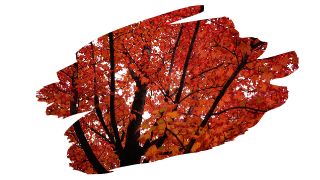A fireplace can be a great way to cut costs on home-heating bills. But, using the right type of firewood, (one that will produce enough heat to warm up your homestead), is the key to savings.
That’s why choosing firewood isn’t as easy as simply throwing any old log onto the fire. And, if you want to stay warm this winter, then you need to use firewood that will burn hot for a while.
So, how does Red Maple lumber measure up as a firewood option?
Well, in this post, we dive into what makes for clean burning firewood. You’ll also discover what the BTU of Red Maple is — and why it matters when it comes to heating your home.
And keep reading to find out how Red Maple measures up as a source of affordable home fuel.

This post may contain affiliate links to products that we receive a commission for (at no additional cost to you). Learn more here.
What Type Of Wood Generally Burns The Cleanest?
Ideal firewood is dry, contains little tree sap, and doesn’t come from a tree that’s harmful to us.
What’s more, if you want firewood to burn for a lengthy amount of time — and really warm up your home — then it needs to be dense as well.
Tough dense woods have more ‘stuff’ for fire to consume. Which, in turn, means that more energy (i.e. heat) is produced when you burn them.
And all of this is the reason why hardwoods, such as White Oak and Birch, make for fantastic firewood.
Related Post: Is Mulberry Tree Wood Good For Firewood?
What About Smoke? What Kind Of Firewood Gives Off Very Little Smoke?
Whenever a log generates a lot of smoke, it indicates that there’s a significant amount of moisture inside that log. And as that firewood burns, that moisture will evaporate — and this makes smoke emissions much thicker.
Basically, if the moisture content of firewood is excessively high, then it will produce an uncontrollable amount of smoke. So, this is why wood must be allowed to dry out first before you burn it.
Now, drying out wood is called ‘seasoning’, and it involves allowing wood to dry for around six to twelve months.
Related Post: How To Season Wood (7 Tips)
And What Does Moisture Content Mean Exactly (When It Comes To Firewood)?
Moisture content is a way to measure the amount of moisture in a piece of wood. This is typically measured using a device called a ‘Moisture Meter’.

When wood is freshly logged, it has a moisture content of around 100%. But, after seasoning, that lumbers moisture content will fall to below 20%.
And What Kind Of Wood Should Never Be Burned In A Fireplace?
Avoid burning any trees that contain poisonous compounds. Those compounds can collect in the soot and smoke produced when you burn these trees.
For this reason, don’t use these toxic wood types (such as the Yew tree) to heat your home.
It’s also important you avoid using wood that has a great deal of tree sap or pitch in it. These wood types, (such as Cedar and Pine wood), pose a fire hazard.
That’s because tree sap/pitch filled wood types can contribute to chimney blockages. And this in turn will increase the risk of a chimney fire starting,
Related Post: Is Acacia Wood A Good Choice For Firewood?
OK Then, What About Red Maple Wood? Is It A Good Firewood?
Well, Red Maple wood meets almost all of the criteria you would look for in firewood.
First off, it is a non-toxic lumber — even despite it’s toxic leaves. You see, the leaves of this tree are toxic. Nonetheless, those toxins do not saturate the sapwood or heartwood of this tree. So, it is safe to burn in a fireplace.
Also, while Red Maple (like most Maple trees) secretes a high amount of sap, that sap is very watery. It is not a thick resinous sap of the kind you would find in say Pine wood. So, you can burn this timber in a fireplace without the worrying risk of chimney fires.
However, there is one aspect of Red Maple wood that makes it a less than ideal choice for your home. And what is that? Well, it’s all about the heat it generates…which is to say, not very much.
Red Maple Wood Isn’t The Best Firewood If You Want To Heat Your Home…
When you compare Red Maple against other more traditional firewood options, Red Maple is not a great fuel choice. You see, one key way that we measure the amount of heat wood produces, is by checking its BTU rating.
The BTU (British Thermal Unit) measures the amount of energy it takes for fire to consume a cord of firewood. The higher the BTU rating, the more energy it requires. And the more energy it requires, the more heat is generated.
White Oak measures in at a very warm 25.7 BTU. While Birch wood clocks in at a slightly lower 23.6 BTU rating.
However, Red Maple wood is a pale flame in comparison, what with it’s rating of a mere 18.1 BTU.
So Should I Avoid Using Red Maple For Firewood?
Well, first off, you can absolutely use Red Maple for firewood. It will burn cleanly and safely in your fireplace.
However, if you are looking for a serious source of fuel, then Red Maple simply doesn’t cut it. Especially when compared against other equally affordable firewood options.
To Wrap Up, Here Are The 3 Key Takeaways From This Post…
- 1). Red Maple wood can be used as firewood. And provided you give it time to dry (before you burn it) it will burn cleanly.
- 2). However, Red Maple wood doesn’t burn for as long as other better firewood options. So, it is not an efficient fuel option for heating your home.
- 3). There are better firewood choices, in the form of White Oak and Birch wood. These alternative hardwoods will provide more heat for your homestead.
References:
Wood Heating | Forestry.usu.edu
Wood Smoke Awareness | EPA.gov



